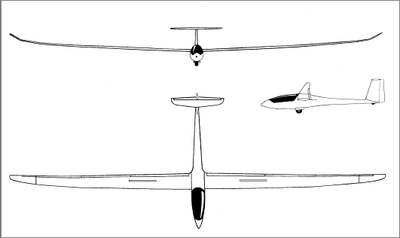Tue, Mar 08, 2022
AD 2022-05-05 Requires Inspecting The Affected Parts Of The Flaperon Control In The Wings...
The FAA is adopting a new airworthiness directive (AD) for all Schempp-Hirth Flugzeugbau GmbH Model Ventus-2a and Ventus-2b gliders.

This AD was prompted by mandatory continuing airworthiness information (MCAI) originated by an aviation authority of another country to identify and correct an unsafe condition on an aviation product. The MCAI describes the unsafe condition as severe corrosion on the inboard flaperon actuation push rods and ball bearing connecting the flaperon push rod to the bell crank inside the wing. This AD requires inspecting the affected parts of the flaperon control in the wings and taking corrective actions if necessary. The FAA is issuing this AD to address the unsafe condition on these products. This AD is effective April 11, 2022.
Supplementary Information: The FAA issued a notice of proposed rulemaking (NPRM) to amend 14 CFR part 39 by adding an AD that would apply to all Schempp-Hirth Flugzeugbau GmbH Model Ventus-2a and Ventus-2b gliders. The NPRM published in the Federal Register on December 6, 2021 (86 FR 68937). The NPRM was prompted by MCAI originated by the European Union Aviation Safety Agency (EASA), which is the Technical Agent for the Member States of the European Union. EASA issued AD 2020-0063, dated March 18, 2020 (referred to after this as “the MCAI”), to address an unsafe condition on Schempp-Hirth Flugzeugbau GmbH Models Ventus-2a, Ventus-2b, Ventus-2c, Ventus-2cM, and Ventus-2cT gliders.
The MCAI states:
- Severe corrosion has been found on the inboard flaperon actuation push rod of some sailplanes. Subsequent investigation determined that, when water ballast is dumped in flight, some water may be sucked into the wing upper side and enter the wing via the flaperon push rod. Intruding water may cause corrosion especially on the ball bearing connecting the flaperon push rod to the bell crank inside the wing.
- This condition, if not detected an[d] corrected, could lead to hard steering (when the ball bearing is damaged) or increased play (when the ball bearing has failed), possibly resulting in reduced control of the (powered) sailplane.
- To address this potential unsafe condition, Schempp-Hirth Flugzeugbau GmbH issued the [technical note] TN to provide inspection and replacement instructions.
- For the reason described above, this [EASA] AD requires repetitive inspections of the affected parts, as identified in the TN, and, depending on findings, replacement with serviceable parts.
You may examine the MCAI in the AD docket at https://www.regulations.gov by searching for and locating Docket No. FAA-2021-1019.
In the NPRM, the FAA proposed to require compliance with the version of the TN (revision 2) identified in the MCAI. The FAA is issuing this AD to address the unsafe condition on these products.
More News
Ultrahigh Frequency (UHF) The frequency band between 300 and 3,000 MHz. The bank of radio frequencies used for military air/ground voice communications. In some instances this may >[...]
During The 7 Second Descent, There Was Another TAWS Alert At Which Time The Engine Remained At Full Power On October 24, 2025 at 2115 mountain daylight time, a Cirrus SR22T, N740TS>[...]
From 2009 (YouTube Edition): Educational Organization Aims to Inspire by Sharing Tuskegee Story Founding leader Don Hinz summarized the Red Tail Project’s mission in simple, >[...]
“This feels like an important step since space travel for people with disabilities is still in its very early days... I’m so thankful and hope it inspires a change in m>[...]
Also: New Katanas, Kern County FD Training, IndiGo’s Botched Roster, MGen. Leavitt Named ERAU Dean The Australian Transportation Safety Bureau (ATSB) has wrapped up its inves>[...]
 ANN's Daily Aero-Term (12.19.25): Ultrahigh Frequency (UHF)
ANN's Daily Aero-Term (12.19.25): Ultrahigh Frequency (UHF) NTSB Prelim: Cirrus Design Corp SR22T
NTSB Prelim: Cirrus Design Corp SR22T Classic Aero-TV: The Red Tail Project--Carrying the Torch of the Tuskegee Airmen
Classic Aero-TV: The Red Tail Project--Carrying the Torch of the Tuskegee Airmen Aero-News: Quote of the Day (12.19.25)
Aero-News: Quote of the Day (12.19.25) Airborne 12.17.25: Skydiver Hooks Tail, Cooper Rotax Mount, NTSB v NDAA
Airborne 12.17.25: Skydiver Hooks Tail, Cooper Rotax Mount, NTSB v NDAA



